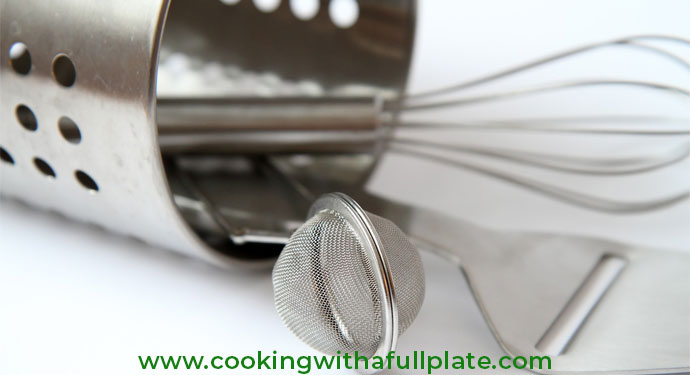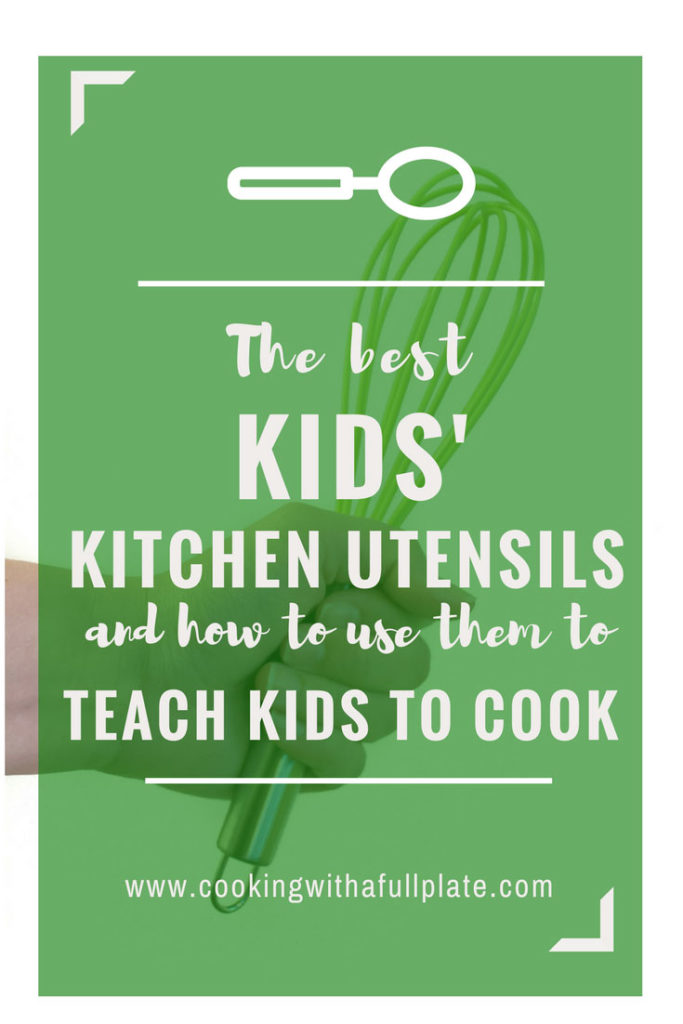You’ve stocked your kitchen with the basic kitchen tools you’ll need to be ready to get your kids helping in the kitchen. Now it’s time to have the best kids’ cooking utensils to make sure that they can get to work!
There are countless skills that getting into the kitchen can help with, including:
- Cleanliness
- Measurements
- Real-world Math
- Kitchen Safety
- Following Instructions
By making sure you have the right kids’ cooking supplies, you can stop stressing about YOUR precious items and instead empower your little ones to get cooking in earnest.
Looking for items that can help you set-up your kitchen for easier and less stressful cooking with your kids? Check out the 4 Types of Kids’ Kitchen Tools you Need.
This post focuses on the utensils that can help you set up your kitchen for a kid-friendly cooking experience.
Kids’ Kitchen Utensils: What to Have, Why to Have Them and How to Use Them
Hand-Powered Utensils
These kids’ kitchen tools are a great way to get started. After all, there’s little to no risk and even if your kiddo isn’t ready to start helping fully, they can spend their time chewing on the silicone end of the spoon or spatula.
In addition, these are not one-use tools. They’re great for kids and adults alike and you may even find a new favorite cooking utensil!
These are some of the most popular types of utensils with our kids (especially that hand-powered egg beater which you can also find at Ikea!):
Measuring Tools
You probably already have all the measuring tools that you need in your kitchen. However, if you’re working with younger kids and really looking to empower them and teach about measurements, you might consider getting some specific, color-coded tools:
My 3-year-old also LOVES using the kitchen scale. Bonus in that you’ll find it helpful too if you’re looking to do some accurate baking!
Kids’ Kitchen Knives
Need help getting dinner ready? Getting a great kitchen knife is one of the best ways to get some extra hands AND teach essential cooking skills. After all, it’s really difficult to make a recipe if you don’t know how to chop and prepare the ingredients.
(FWIW – the StarPack are the ones that we use and love!)
Obviously, it’s super important to be safe when letting kids work with knives. In the coming weeks I’ll be talking more about teaching kids to chop safely, but in the meantime, get yourself a safe kitchen knife for your kids! I think you’ll find it’s one of your most used children’s cooking utensils.
Using Kids’ Kitchen Utensils to Teach Basic Cooking Skills
For the youngest kids (2-3 years old):
- At this age, just getting your kids into the kitchen can have the biggest impact. No need to be structured or get fancy.
- Kiddos at this age can use a butter knife to help chop or one of the kids’ knives above with a lot of supervision.
- 2-3 year olds are great at helping with mixing and stirring. My son loved having “his own” colorful whisk that he could use anytime he wanted.
- This isn’t a great age for accurate measuring, but letting little ones play with measuring utensils can be a great way to help them get comfortable and keep them busy!
- Really need to get some cooking done with little ones around? I find that small bowls like this along with some utensils and a bowl of uncooked rice is a great sensory activity that can keep them busy for a surprisingly long amount of time. Just be sure to have a broom and/or splat mat handy for the aftermath!
For elementary school-aged kids (4-8 years old):
- This is the perfect age to start getting your kids involved with chopping using kids’ knives like the ones above. We have found the most success in starting with soft things like:
- Bananas
- Strawberries
- Slices of bread
- You can then help them gradually increase the difficulty of the products they’re chopping with your oversight. This would be a great time to talk to them about the “claw grip” where they keep the fingers of the stabilizing hand curled under. This video has some great tips for adults and kids alike:
- This is also a great age to start talking about measuring and the proper way to do it. I love the colored measuring utensils for this purpose, especially before kids are fully proficient with numbers and fractions.
- Learning specific skills like: cracking eggs, beating together butter and sugar for cookies, and more.
For older kids (9 years old – pre-teen):
- As kids get a little older (and more responsible) you may find that a bigger and stronger knife helps to increase their confidence and skills. We love this one for its sharp edge but still manageable size.
- Allow them to help in multiplying or dividing recipes, adding up fractions, and measuring ingredients.
- This is the age when I’d also start letting kids practice cooking with heat, with supervision. A tool like the Instant Pot, where you are sauteeing without a flame, could be a great place to start (though you’d obviously want to be super careful with the pressure cooker function)
- This is also a great age to let kids do some cooking on their own! Here are some fantastic recipes that you might let them try.
Note: Once your teenagers are ready to start working with kitchen knives in earnest, I mostly recommend just finding something they feel comfortable with.
My hubby and I actually have different knives we use in the kitchen because we prefer a different weight and handle grip.
This is my favorite affordable but still strong options that you might consider if you or your older kids are looking for a great kitchen knife:
Want more ideas and recipes for cooking with kids? You should definitely check out Kate Young’s channel on YouTube.
This post contains affiliate links. As an Amazon Associate I earn from qualifying purchases.
